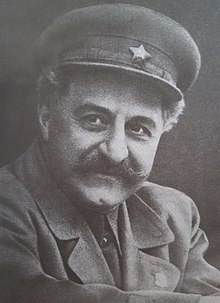Sergo Ordzhonikidze | |
|---|---|
| სერგო ორჯონიკიძე Серго Орджоникидзе | |
 Ordzhonikidze in 1937 | |
| People's Commissar of Heavy Industry | |
| In office 5 January 1932 – 18 February 1937 | |
| Preceded by | Position established; Himself as Chairman of the Supreme Soviet of the National Economy |
| Succeeded by | Valery Mezhlauk |
| Chairman of the Supreme Soviet of the National Economy | |
| In office 10 November 1930 – 5 January 1932 | |
| Preceded by | Valerian Kuybyshev |
| Succeeded by | Position abolished; Himself as People's Commissar of Heavy Industry |
| People's Commissar of the Workers' and Peasants' Inspectorate | |
| In office 5 November 1926 – 10 November 1930 | |
| Preceded by | Valerian Kuybyshev |
| Succeeded by | Andrey Andreyev |
| Full member of the 16th, 17th Politburo | |
| In office 21 December 1930 – 18 February 1937 | |
| Candidate member of the 14th Politburo | |
| In office 23 July 1926 – 3 November 1926 | |
| Personal details | |
| Born | Grigol Konstantines dze Ordzhonikidze 24 October [O.S. 12 October] 1886 Ghoresha, Kutais Governorate, Russian Empire |
| Died | 18 February 1937 (aged 50) Moscow, Russian SFSR, Soviet Union |
| Resting place | Kremlin Wall Necropolis, Moscow |
| Political party |
|
Sergo Konstantinovich Ordzhonikidze[a] (born Grigol Konstantines dze Orjonikidze;[b] 24 October [O.S. 12 October] 1886 – 18 February 1937) was a Georgian-born Bolshevik and Soviet politician.
Born and raised in Georgia, in the Russian Empire, Ordzhonikidze joined the Bolsheviks at an early age and quickly rose within the ranks to become an important figure within the group. Arrested and imprisoned several times by the Russian police, he was in Siberian exile when the February Revolution began in 1917. Returning from exile, Ordzhonikidze took part in the October Revolution that brought the Bolsheviks to power. During the subsequent Civil War he played an active role as the leading Bolshevik in the Caucasus, overseeing the invasions of Azerbaijan, Armenia, and Georgia. He backed their union into the Transcaucasian Socialist Federative Soviet Republic (TSFSR), which helped form the Soviet Union in 1922 and served as the First Secretary of the TSFSR until 1926.
Promoted to lead the Workers' and Peasants' Inspectorate (Rabkrin), Ordzhonikidze moved to Moscow and joined the inner circle of top Bolsheviks. Tasked with overseeing Soviet economic production, Ordzhonikidze led a massive overhaul of Rabkrin and its associated bodies, noting inefficiencies within the Supreme Soviet of the National Economy (Vesenkha). In 1930 he was transferred to lead Vesenkha, which was re-formed as the People's Commissariat of Heavy Industry (NKTP) in 1932. While there, Ordzhonikidze oversaw the implementation of the five-year plans for economic development and helped create the Stakhanovite movement of model Soviet workers. At the same time, he was named to the Politburo, the leading political body in the Soviet Union.
Ordzhonikidze was reluctant to take part in the campaigns against so-called wreckers and saboteurs that began in the early 1930s, causing friction between himself and his longtime friend Joseph Stalin, whom he helped during his rise to power. Realizing the need for people experienced in their fields, Ordzhonikidze refused to purge older workers or disassociate himself from individuals deemed anti-Bolshevik. According to some theories, his relationship with Stalin deteriorated and, on the eve of a 1937 meeting where he was expected to denounce workers, Ordzhonikidze shot himself and died at his home, though this has been contested.
Cite error: There are <ref group=lower-alpha> tags or {{efn}} templates on this page, but the references will not show without a {{reflist|group=lower-alpha}} template or {{notelist}} template (see the help page).